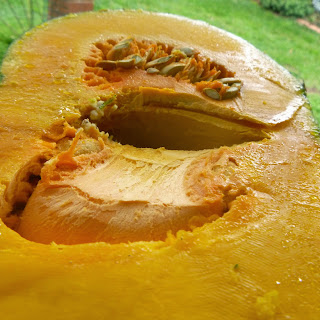Sometimes life can be a little rough, with unforeseen accidents, petty politics at work or unexpected real live genuine betrayals that
would have The Bold and the Beautiful scriptwriters slow-clapping in
appreciation.
Usually the overwhelming instinct is to head for some greasy
hot food, ice-cream or a bucket-sized glass of vino. For me, it’s chocolate and
a lot of it, even if it is homemade raw chocolate, full of antioxidants and
minerals, and infused with orange essential oil, which has antidepressant and
anti-inflammatory properties. And
therein lies the key. Indulge in your go-to comfort foods, but also seek out
foods that nourish. Find something delicious that will promote healing
and happiness for both the body and the mind.
This hearty, delicious soup ticks those boxes and best of
all, it’s easy and you can use pretty much whichever vegies you have handy. For
me this week that included organic supermarket carrots, a spring onion out of
the backyard, a jar of my preserved summer tomatoes, and a bunch of Tuscan kale
from my community garden plot.
 |
| Egg shells around baby plants stop slugs and snails |
Kale is super easy to grow from seed, either planted direct
or in pots and transplanted as 10-cm high seedlings. It’s also absurdly good
for you, with plenty of vitamins, minerals, omega-3 fatty acid and
antioxidants. Give it a sunny spot with good soil, let it grow to a decent size
over the next couple of months, then pick the small, tender leaves for salads
or the larger leaves for casseroles and soups. Chop it finely and cook it a
little longer than you would spinach.
Kale will grow throughout the year. Happily, it prefers
cooler climates like Canberra, where our winter frosts knock out the pesky white
cabbage butterfly caterpillars and replace the kale’s often bitter, sulphurous
summer taste with a fresh sweetness. The best way to deal with the destructive
caterpillars organically is to put a finely-woven net around the plant to
prevent the butterflies from landing and laying their tiny bright yellow eggs.
Some garden experts suggest ‘planting’ fake butterflies around the plants so
the real butterflies think the territory is already taken and leave. My margarine
container-lid impostors had the opposite effect, attracting large numbers of
lovelorn butterflies.
 |
| My happy kale plants in my community garden plot. |
If you don’t protect your plants it’s best to inspect them daily
for the eggs, which you can simply brush off the plant, and the caterpillars, which
you can either squish or relocate to a distant park. Otherwise, they can do
some serious damage and add some surprise protein to your green smoothie. Kale
can also attract aphids but keep it strong and healthy with regular feeds and
watering and it will be able to better resist them.
 |
| The lentils and sautéed vegies |
Back to the soup - I also include a generous serve of
lentils, which keep you full, improve digestion, support a healthy heart, help combat
cancer, promote weight loss, and have good doses of iron, folate and potassium.
Finally, I use fresh turmeric, which is just as full of vitaminy goodness but
also anti-inflammatory and enhances brain chemicals that manage happiness, pleasure
and pain.
So here it is, my hearty vegie soup.
Add a good drizzle of extra virgin olive oil to a large
saucepan on the stove over a medium heat. Toss in some diced onion, kale,
carrots, celery, parsley, a bay leaf and any other herbs and vegies you’ve got in
the fridge or garden plus some finely grated turmeric. Sauté for several
minutes until the vegies soften slightly.
Rinse a cup of dried orange lentils very well and add to the
pan, along with your preserved or canned tomatoes. Stir well then add a few
cups of your favourite stock. Bring to the boil, reduce the heat and leave to
simmer for the next 45 minutes or until the lentils have broken down and the
soup has a lovely rich colour.
Season with salt and pepper and serve. A slosh of organic
apple cider vinegar (white vinegar works fine) in each bowl will complement the
richness of the soup perfectly.


















